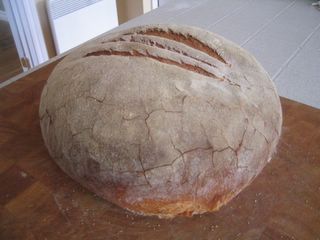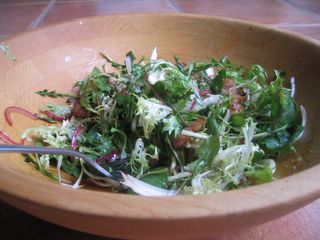Our love affair with stew continues with this basic recipe. The starting point of any meat stew is, naturally,
meat. Take your pick of beef, pork or lamb (or venison or raccoon or ...). Shoulder, neck and shank (foreleg) are the choice cuts for stewing (beef shoulder is called chuck, BTW).
For every pound of meat, you want
- a tablespoon of fat
- an onion the size of your fist, chopped coarsely
- a minced clove of garlic
- a cup or two of veggies coarsely chopped or beans
- a cup of liquid
- a tablespoon of flour
- seasonings
The technique is straightforward. Brown the chunks of meat all over in the fat in a heavy, ovenproof pan (I use a Dutch oven). Add the onions and stir until softened. Add the garlic and cook just until you can smell it. Add the flour and stir. Add the liquid and bring to a boil while scraping the bottom of the pot. Cover and put in a 250 degree oven for 2-3 hours until meat falls apart when you prod it with a fork. Root veggies (carrots, parsnips, spuds) are added about an hour into cooking and anything else about 15 minutes before you take the stew out of the oven. Canned beans or chickpeas are also added around then. I like to use beans to stretch my stew when possible. Some traditional stews, however, like boeuf bourguignon, just wouldn't seem right with this addition.
Unless you're making enough for an army, it takes about 30 minutes to get the stew ready to go in the oven. At this point you could opt instead for a slowcooker. On the low setting, most stews take 8-12 hours in the "mijoteuse". There is less evaporative loss, so cut the liquid and flour in half.
Now for the infinite variations. For fat, bacon or salt pork are popular choices. Try out the fat over medium heat before adding the chunks of meat. Of course, these fats add a strong (delicious) flavour to the stew. Butter, duck fat or olive oil are other yummy options. The liquid is usually some combination of stock and wine, but beer, fruit and vegetable juices and, heck, even water also work. If you're making a beef or veal stew and have real veal stock on hand (or some demiglace), then this is the way to go. For seasonings, I usually start with 1/2 tsp of salt and 1/4 tsp of pepper per pound of meat.
With beef, I like thyme and bay. Sage and rosemary are good with lamb or pork and white kidney beans. Cumin, turmeric, cinnamon and cardamom (Persian seasonings) are great with lamb and chickpeas. Mustard, thyme and brandy soaked prunes are great (and traditionally French) with pork (finish the stew with heavy cream). A heaping tbsp of chopped fresh parsley is a nice finish to any stew.
I serve stew either with bread alone (whatever I can find that most closely approximates the Sullivan Street filone) or with boiled potatoes or buttered egg noodles. I prefer to serve "mush", like mashed potatoes or polenta, with things less saucy, like roast chicken or pot roast or braised lamb or veal shanks (osso bucco).





